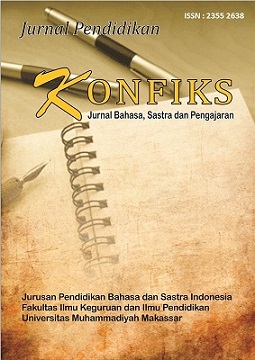SPEECH ACTS OF BULLYING AGAINST WOMEN IN THE FILM SERIES "THE GLORY"
DOI: https://doi.org/10.26618/4jczqm43
Abstract
Bullying is a social phenomenon that frequently occurs across various levels of society, including educational settings that should serve as spaces for human character development. The high prevalence of bullying cases in Indonesia indicates that acts of intimidation remain a serious issue, particularly for women who are more vulnerable to psychological pressure. The Korean drama The Glory explicitly depicts various forms of bullying against female students, making it relevant to be analyzed through a pragmatic perspective. This study aims to explain the types of verbal bullying speech acts against women in The Glory, the forms of utterances used, and the resulting psychological impacts. This research employs a qualitative-descriptive method with data collected through observation and note-taking of utterances in the film containing verbal bullying. The data were analyzed using Searle’s speech act theory and the interactive model of Miles, Huberman, and Saldana, while data validity was ensured through triangulation of methods, sources, and instruments. The findings show that verbal bullying speech acts include directive, representative, assertive, and expressive types. The forms of verbal bullying comprise shouting harshly, threatening and intimidating, mocking and belittling, and using degrading nicknames. The psychological impacts include anxiety, depression, low self-esteem, social isolation, and post-traumatic stress disorder (PTSD). This study emphasizes that speech act analysis in films can serve as an educational medium to raise public awareness of the dangers of verbal bullying against women.
Downloads
Published
Issue
Section
License

This work is licensed under a Creative Commons Attribution 4.0 International License.
Authors who publish with this journal agree to the following terms:
The author owns the copyright and grants the journal rights for first publication with the work simultaneously licensed under a Creative Commons Attribution License which allows others to share the work with acknowledgment of the work's authorship and initial publication in this journal.
Authors may enter into separate additional contractual agreements for the non-exclusive distribution of the published journal version of the work (for example, posting it to an institutional repository or publishing it in a book), with acknowledgment of its initial publication in this journal.
Authors are permitted and encouraged to post their work online (for example, in institutional repositories or on their websites) before and during the submission process, as this can lead to productive exchanges, as well as earlier and larger citations of published work (See The Effect of Open Access).
Statement of Authenticity and Manuscript Copyright can be downloaded: Here
After filling in the statement letter, please send via e-mail: konfiks@unismuh.ac.id





.png)


